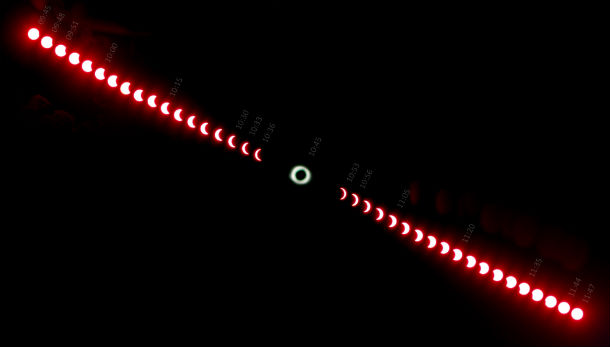

Photo courtesy of Kalan [CC BY 3.0], via Wikimedia Commons
As I mentioned in my last article, a total solar eclipse is a symphony of light and shadow, and you are the conductor. While key events will occur on schedule, only you can orchestrate how and when to observe the phenomena accompanying them. The following timetable of events can help prepare you for what to expect and when to expect it, for maximum enjoyment.
The Timetable
First contact (the eclipse begins). Look for a tiny black notch in the Sun's western limb. Like a finger striking a piano key three times in succession, the event occurs first in a telescope, then in binoculars, and finally to the unaided eye. Be sure to know exactly when and where to look along the Sun's limb to see it.
First 30 minutes. Make notes on the environment:
- Record the appearance of, and colors in, the landscape, sky, and clouds: Focus your attention along the horizon (north, south, east, and west), as the most dramatic changes will occur there.
- What is the quality of light, hard or soft? Hard light creates well-defined, high-contrast shadows; soft light renders shadows difficult to distinguish. The eclipse will start off hard but become increasingly soft, as totality nears.
- Open your senses: what's the temperature? Is there a wind? If so, what's the direction? How are birds and animals behaving? What sounds do you hear? How does the air smell (sweet, dry, moist)?
If you have a telescope with a safe solar filter, stare at the Moon's advancing limb. Does a band of light materialize just beyond it? It's an optical illusion — a bright afterimage of the Moon's black silhouette.
~ half eclipsed. Has the temperature dropped? Feel any wind or breezes? Project solar crescents onto your white cardboard: Use your fingers, straw hat, colander, or pinhole projector. Look for them occurring naturally on the ground under a tree (from sunlight shining through tiny spaces between leaves).
~ 30 minutes before totality. Repeat your observations of the environment. The intensity and quality of light should have changed perceptibly. If you cast a shadow of your finger against your card, it will appear fuzzier on one side than on the other; it will be fuzzier on the side where the Sun is being eclipsed. Move your finger further from the card, and it will appear more curved.
~ 20 minutes before totality. Repeat your observations of the environment: Colors should have begun to fade like an old print. You may see deeper into shadows as the quality of light softens. The eastern sky should turn yellow, while the western sky will look brooding.
~ 10 minutes before totality. Repeat your observations of the environment: The Moon's shadow should now be visible on the western horizon looking like a gathering squall. Bright planets should now be visible. The temperature may have dropped significantly. Birds may behave erratically.
~ 4 minutes before totality. Repeat your observations of the environment: birds may start to roost, cows and other animals may appear confused. Wedges of tangerine light will infiltrate the sky above the north and south horizons. The western sky looks dark and ominous.
~ 2 minutes before totality. Look for shadow bands — alternating dark and light bands that wash across the ground like waves in a pool. This atmospheric phenomenon arises when light from the Sun's narrowing crescent interacts with turbulent bundles of air in Earth's atmosphere.
~15 seconds before totality. The solar crescent breaks like quicksilver into delicate beads of sunlight. Called Baily's Beads, they are the dying rays of sunlight passing through lunar valleys.
~10 seconds before totality. Baily's Beads "dry up" — blinking out until one last one, the Diamond Ring, forms on the eastern limb of the Moon.
REMOVE YOUR ECLIPSE VIEWING GLASSES NOW!
~ five seconds before totality. Face west and sweep your eyes back and forth across the sky from north to south to see the large and spooky Moon's shadow crashing into the Sun in concert with the death of the Diamond Ring. Your descent into darkness has begun!
Second contact (Totality)! The Sun's ethereal corona will immediately steal your attention. If you're lucky, you will also catch a brief glimpse of the Sun's red middle atmosphere (chromosphere) and a bloody finger or two extending into the corona; these are actually giant prominences — eruptions of huge quantities of gaseous matter spewing from the Sun's surface.
Mid-totality. Repeat your observations of the environment. The sky does not turn completely dark during totality. The Sun's corona is about as bright as a full Moon, so it illuminates the landscape softly with a pearly light. The sky will glow orange beyond the blanket of the Moon's shadow, so the look and feel of the sky is more like deep twilight with a few bright stars and planets.
Third contact (end of totality).
PUT YOUR ECLIPSE VIEWING GLASSES BACK ON NOW! ...
Repeat all the observations above ... but in reverse.
Fourth contact. The Moon separates completely from the Sun, and the magnificent show is over.
CAUTION: Never look at the Sun, either directly or through a telescope or binocular, without a professionally made protective solar filter installed that completely covers the front of the instrument, or permanent eye damage could result. When using a truss tube telescope to view the Sun, both a properly fitting solar filter and light shroud are required.
 |
Stephen James O'Meara is an award-winning visual observer, whose writings, lectures, and numerous books on amateur astronomy have inspired observers across the globe to see the sky in new and wonderful ways. A contributing editor for Astronomy magazine, Stephen is an avid "eclipse chaser", having witnessed a dozen total solar eclipses dating back to 1959 (when he was 3 years old). |

















